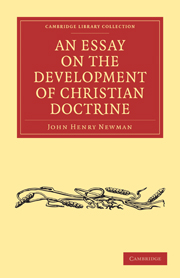Book contents
- Frontmatter
- ADVERTISEMENT
- Contents
- INTRODUCTION
- CHAPTER I ON THE DEVELOPMENT OF IDEAS
- CHAPTER II ON THE DEVELOPMENT OF CHRISTIAN IDEAS, ANTECEDENTLY CONSIDERED
- CHAPTER 3 ON THE NATURE OF THE ARGUMENT IN BEHALF OF THE EXISTING DEVELOPMENTS OF CHRISTIANITY
- CHAPTER IV ILLUSTRATIONS OF THE ARGUMENT IN BEHALF OF THE EXISTING DEVELOPMENTS OF CHRISTIANITY
- CHAPTER V ILLUSTRATIONS CONTINUED
- CHAPTER VI ILLUSTRATIONS CONTINUED
- CHAPTER VII ILLUSTRATIONS CONTINUED
- CHAPTER VIII ILLUSTRATIONS CONCLUDED
CHAPTER VI - ILLUSTRATIONS CONTINUED
Published online by Cambridge University Press: 16 May 2011
- Frontmatter
- ADVERTISEMENT
- Contents
- INTRODUCTION
- CHAPTER I ON THE DEVELOPMENT OF IDEAS
- CHAPTER II ON THE DEVELOPMENT OF CHRISTIAN IDEAS, ANTECEDENTLY CONSIDERED
- CHAPTER 3 ON THE NATURE OF THE ARGUMENT IN BEHALF OF THE EXISTING DEVELOPMENTS OF CHRISTIANITY
- CHAPTER IV ILLUSTRATIONS OF THE ARGUMENT IN BEHALF OF THE EXISTING DEVELOPMENTS OF CHRISTIANITY
- CHAPTER V ILLUSTRATIONS CONTINUED
- CHAPTER VI ILLUSTRATIONS CONTINUED
- CHAPTER VII ILLUSTRATIONS CONTINUED
- CHAPTER VIII ILLUSTRATIONS CONCLUDED
Summary
APPLICATION OF THE SECOND TEST OF FIDELITY IN DEVELOPMENT.
It appears then that there has been a certain general type of Christianity in every age, by which it is known at first sight, as any physical production, animal or vegetable, is named at once by those to whom such forms of nature are familiar; or as some work of literature or art is at once assigned to its right author by the critic, difficult as may be the analysis of that specific impression by which he is enabled to do so. And it appears that this type has remained entire from first to last, in spite of that process of development which seems to be attributed by all parties, for good or bad, to the doctrines, rites, and usages in which Christianity consists; or, in other words, that the changes which have taken place in Christianity have not been such as to destroy that type,–that is, that they are not corruptions, because they are consistent with that type. Here then, in the preservation of type, we have a first proof of the fidelity of the existing developments of Christianity. Now we proceed to a second.
When the Christian developments are spoken of, it is sometimes supposed that they are deductions and divertions made at random, according to accident or the caprice of individuals; whereas, if they really deserve the name, they must be conducted all along on definite and continuous principles, which determine their course.
- Type
- Chapter
- Information
- An Essay on the Development of Christian Doctrine , pp. 318 - 368Publisher: Cambridge University PressPrint publication year: 2010First published in: 1845



